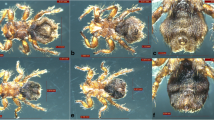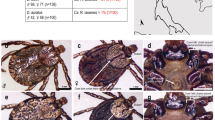Abstract
Mites are often overlooked as vectors of pathogens, but have been shown to harbor and transmit rickettsial agents such as Rickettsia akari and Orientia tsutsugamushi. We screened DNA extracts from 27 mites representing 25 species of dermanyssoids for rickettsial agents such as Anaplasma, Bartonella, Rickettsia, and Wolbachia by PCR amplification and sequencing. DNA from Anaplasma spp., a novel Bartonella sp., Spiroplasma sp., Wolbachia sp., and an unclassified Rickettsiales were detected in mites. These could represent mite-borne bacterial agents, bacterial DNA from blood meals, or novel endosymbionts of mites.
Similar content being viewed by others
References
D.M. Allred (1954) ArticleTitleMites as intermediate hosts of tapeworms Proc. Utah Acad. Sci., Arts Lett. 31 44–51
T. Beninati N. Lo L. Sacchi C. Genchi H. Noda C. Bandi (2004) ArticleTitleA novel Alpha- Proteobacterium resides in the mitochondria of ovarian cells of the tick Ixodes ricinus Appl. Environ. Microbiol. 70 2596–2602 Occurrence Handle10.1128/AEM.70.5.2596-2602.2004 Occurrence Handle1:CAS:528:DC%2BD2cXktlCgu78%3D Occurrence Handle15128508
J.M. Bove (1997) ArticleTitleSpiroplasmas: infectious agents of plants, arthropods and vertebrates Wien. Klin. Wochenschr. 109 604–612 Occurrence Handle1:STN:280:ByiH3s3gs1A%3D Occurrence Handle9286068
M. Carl C.W. Tibbs M.E. Dobson S. Paparello G.A. Dasch (1990) ArticleTitleDiagnosis of acute typhus infection using the polymerase chain reaction J. Infect. Dis. 161 791–793 Occurrence Handle1:STN:280:By%2BB3czntlQ%3D Occurrence Handle2108225
R. Concannon K. Wynn-Owen V.R. Simpson R.J. Birtles (2005) ArticleTitleMolecular characterization of haemoparasites infecting bats (Microchiroptera) in Cornwall, UK Parasitology 131 1–8 Occurrence Handle10.1017/S0031182005008097
P. Fernandez-Soto R. Perez-Sanchez A. Encinas-Grandes (2001) ArticleTitleMolecular detection of Ehrlichia phagocytophila genogroup organisms in larvae of Neotrombicula autumnalis (Acari: Trombiculidae) captured in Spain J. Parasitol. 87 1482–1483 Occurrence Handle1:STN:280:DC%2BD38%2FlsFejsg%3D%3D Occurrence Handle11780844
J.L. Goodman (2005) Human granulocytic anaplasmosis (ehrlichiosis) J.L. Goodman D.T. Dennis D.E. Soneshine (Eds) Tick-Borne Diseases of Humans ASM Press Washington, DC 218–238
R.J. Huebner W.L. Jellison C. Pomerantz (1946) ArticleTitleRickettsialpox – a newly recognized rickettsial disease IV. Isolation of a Rickettsia apparently identical with the causative agent of rickettsialpox from Allodermanyssus sanguineusa rodent mite Public Health Rep. 61 1677–1682
H. Inokuma D. Raoult P. Brouqui (2000) ArticleTitleEpidemiological survey of Anaplasma platys and Ehrlichia canis using ticks collected from dogs in Japan Vet. parasitol. 38 4219–4221 Occurrence Handle1:CAS:528:DC%2BD3MXhs1Slu7s%3D
H. Inokuma M. Oyamada P.J. Kelly L.A. Jacobson P.E. Fournier K. Itamoto M. Okuda P. Brouqui (2005) ArticleTitleMolecular detection of a new Anaplasma species closely related to Anaplasma phagocytophilum in canine blood from South Africa J. Clin. Microbiol. 43 2934–2937 Occurrence Handle10.1128/JCM.43.6.2934-2937.2005 Occurrence Handle15956424
M.L. Levin W.L. Nicholson R.F. Massung J.W. Sumner D. Fish (2002) ArticleTitleComparison of the reservoir competence of medium-sized mammals and Peromyscus leucopus for Anaplasma phagocytophilum in Connecticut Vector Borne Zoonotic Dis. 2 125–136 Occurrence Handle10.1089/15303660260613693 Occurrence Handle12737542
A.D. Loftis J.S. Gill M.E. Schriefer M.L. Levin M.E. Eremeeva M.J.R. Gilchrist G.A. Dasch (2005) ArticleTitleDetection of RickettsiaBorrelia and Bartonella in Carios kelleyi (Acari: Argasidae) J. Med. Entomol. 42 473–480 Occurrence Handle1:CAS:528:DC%2BD2MXkvVCgsb8%3D Occurrence Handle15962801
H.A. Mohamed D.H. Molyneux K.R. Wallbanks (1987) ArticleTitleA coccidian in haemogamasid mites; possible vectors of Elleipsisoma thomsoni Annales de parasitologie humaine et comparée 62 107–116 Occurrence Handle1:STN:280:BiiB3sbos1Y%3D Occurrence Handle3592490
W.W. Moss (1978) ArticleTitleThe mite genus Dermanyssus: a survey, with description of Dermanyssus trochilinisn. sp., and a revised key to the species (Acari: Mesostigmata: Dermanyssidae) J. Med. Entomol. 14 627–640
Reeves W.K., Loftis A.D., Gore J.A. and Dasch G.A. 1995. Molecular evidence for novel Bartonella spp. in Trichobius major (Diptera: Streblidae) and Cimex adjunctus (Hemiptera: Cimicidae) from two southeastern bat caves, U.S.A. J. Vector Ecol. 30: 339–341.
A. Renz P. Wenk (1981) ArticleTitleIntracellular development of the cotton-rat filaria Litomosoides carinii in the vector mite Ornithonyssus bacoti Trans. Roy. Soc. Trop. Med. Hygiene 75 166–168 Occurrence Handle1:STN:280:Bi6B2srpslA%3D
R. Traub C.L. Wisseman A. Farhang-Azad (1978) ArticleTitleThe ecology of murine typhus- a critical review Trop. Dis. Bull. 75 237–317 Occurrence Handle1:STN:280:CSaD3snkvFE%3D Occurrence Handle705902
D.E. Walter M. Shaw (2005) Mites and disease W.C. Marquardt (Eds) Biology of Disease Vectors Elsevier Academic Press Amsterdam 25–44
W.G. Weisburg S.M. Barns D.A. Pelletier D. Lane (1991) ArticleTitle16S ribosomal DNA amplification for phylogenetic study J. Bacteriol. 173 697–703 Occurrence Handle1:CAS:528:DyaK3MXhsl2lurY%3D Occurrence Handle1987160
C.E. Yunker J.M. Brennan L.E. Hughes C.B. Phillip C.M. Clifford P.H. Peralta J. Vogel (1975) ArticleTitleIsolation of viral and rickettsial agents from Panamanian Acarina J. Med. Entomol. 12 250–255 Occurrence Handle1:STN:280:CSmD3cjks1M%3D Occurrence Handle1159751
C.E. Yunker (1964) ArticleTitleInfections of laboratory animals potentially dangerous to man: ectoparasites and other arthropods, with emphasis on mites Lab. Anim. Care 14 455–465 Occurrence Handle1:STN:280:CCqD3Mnntl0%3D Occurrence Handle14212347
Author information
Authors and Affiliations
Corresponding author
Rights and permissions
About this article
Cite this article
Reeves, W.K., Dowling, A.P.G. & Dasch, G.A. Rickettsial Agents from Parasitic Dermanyssoidea (Acari: Mesostigmata). Exp Appl Acarol 38, 181–188 (2006). https://doi.org/10.1007/s10493-006-0007-1
Received:
Accepted:
Issue Date:
DOI: https://doi.org/10.1007/s10493-006-0007-1




